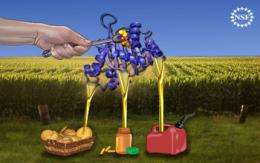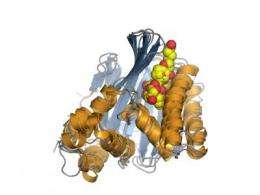Cellular secrets of plant fatty acid production understood; discovery could boost bioeconomy

(Phys.org) -- Research groups from Iowa State University and the Salk Institute for Biological Studies have uncovered the function of three plant proteins, a discovery that could help plant scientists boost seed oil production in crops, thereby benefitting the production of food, biorenewable chemicals and biofuels.
The analysis of gene activity (by the Iowa group) and determination of protein structures (by the Salk group) independently identified in the model plant thale cress (Arabidopsis thaliana) three related proteins that appear to be involved in fatty-acid metabolism. The Iowa and Salk researchers then joined forces to test this hypothesis, demonstrating a role of these proteins in regulating the amounts and types of fatty acids accumulated in plants. The researchers also showed that the action of the proteins is very sensitive to temperature and that this feature may play an important role in how plants mitigate temperature stress using fatty acids.
The discovery is published online at nature.com, the website of the journal Nature. Corresponding authors are Eve Syrkin Wurtele, a professor of genetics, development and cell biology at Iowa State; and Joseph Noel, a professor and director of the Jack H. Skirball Center for Chemical Biology and Proteomics at the Salk Institute in La Jolla, Calif., and an investigator with the Howard Hughes Medical Institute.
"This work has major implications for modulating the fatty-acid profiles in plants, which is terribly important, not only to sustainable food production and nutrition but now also to biorenewable chemicals and fuels," Noel said.
"Because very high-energy molecules such as fatty acids are created in the plant using the energy of the sun, these types of molecules may ultimately provide the most cost-effective and efficient sources for biorenewable products," Wurtele added.
Although the researchers now understand that the three proteins - dubbed fatty-acid-binding proteins one, two and three, or FAP1, FAP2 and FAP3 - are involved in fatty-acid accumulation in plant tissues such as leaves and seeds, Wurtele said researchers still don't understand the physical mechanism these proteins employ at the molecular level. That knowledge will ultimately allow the two collaborating research groups to predictably engineer better functions in plants.
To identify the proteins' function in plants, Wurtele's research group used its expertise in molecular biology and bioinformatics (the application of computer technologies to biological studies).

One tool the Iowa State researchers used was MetaOmGraph, software they developed to analyze large sets of public data about the patterns of gene activity under different developmental, environmental and genetic changes. The software revealed that the expression patterns of the FAP genes resemble those of genes encoding enzymes of fatty-acid synthesis. The analyses also showed that the accumulation of two of the proteins is highest in the regions of the plant where the greatest amount of oil is produced. These clues led the researchers to predict that the three FAP proteins are important for fatty-acid accumulation.
The Iowa State researchers then tested this theory experimentally by comparing the fatty acids of mutant plants lacking the FAP proteins to those of normal plants. Despite the healthy appearance of the mutant plants, the overall fatty-acid content is greater than in the normal plants, and the types of fatty acids differ.
Noel and researchers at the Salk Institute used a variety of techniques - including X-ray crystallography and biochemistry - to characterize the structures of the FAP1, FAP2 and FAP3 proteins, and to determine that the proteins bind fatty acids.
"The proteins appear to be crucial missing links in the metabolism of fatty acids in Arabidopsis, and likely serve a similar function in other plant species since we find the same genes spread throughout the plant kingdom," said Ryan Philippe, a post-doctoral researcher in Noel's lab.

First authors of the paper are Micheline Ngaki, a Fulbright Scholar from the Congo and a graduate student in genetics, development and cell biology at Iowa State; Gordon Louie, a research scientist at the Salk Institute; and Philippe. Other collaborators include Ling Li, an Iowa State adjunct assistant professor and associate scientist in genetics, development and cell biology; Gerard Manning, director of Salk's Razavi Newman Center for Bioinformatics; and Marianne Bowman, Florence Pojer and Elise Larsen, Howard Hughes Medical Institute researchers in the Salk's Skirball Center.
The project was supported in part by the National Science Foundation including the Engineering Research Center for Biorenewable Chemicals based at Iowa State, the National Cancer Institute, the Howard Hughes Medical Institute and Ngaki's Fulbright award. Additional support came from Iowa State's Plant Sciences Institute.
Discovery of the connection between the FAP proteins and plant fatty acids could be very useful to plant scientists.
"If the researchers can understand precisely what role the proteins play in seed oil production," said Ngaki, "they might be able to modify the proteins' activity in new plant strains that produce more oil or higher quality oil than current crops."
Further, if the three proteins help plants regulate stress, plant scientists might be able to exploit that trait to develop plants that are more resistant to stress, Wurtele said. And that could allow farmers to grow crops for biorenewable fuels and chemicals on marginal land that's not suited for food crops.
All of this, she said, could point to new directions in biological studies.
"We are entering the age of predictive biology," Wurtele said. "That means harnessing computational approaches to deduce gene function, model biological processes and predict the consequences of altering a single gene to the complex biological network of an organism."
More information: Nature, Evolution of the chalcone isomerase fold from fatty acid-binding to stereospecific catalysis, Micheline N. Ngaki, et al.
Journal information: Nature
Provided by Iowa State University



















